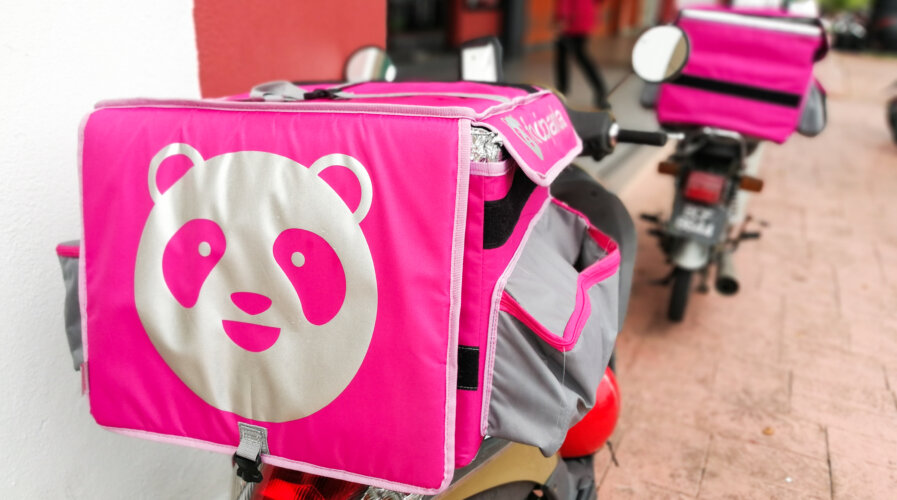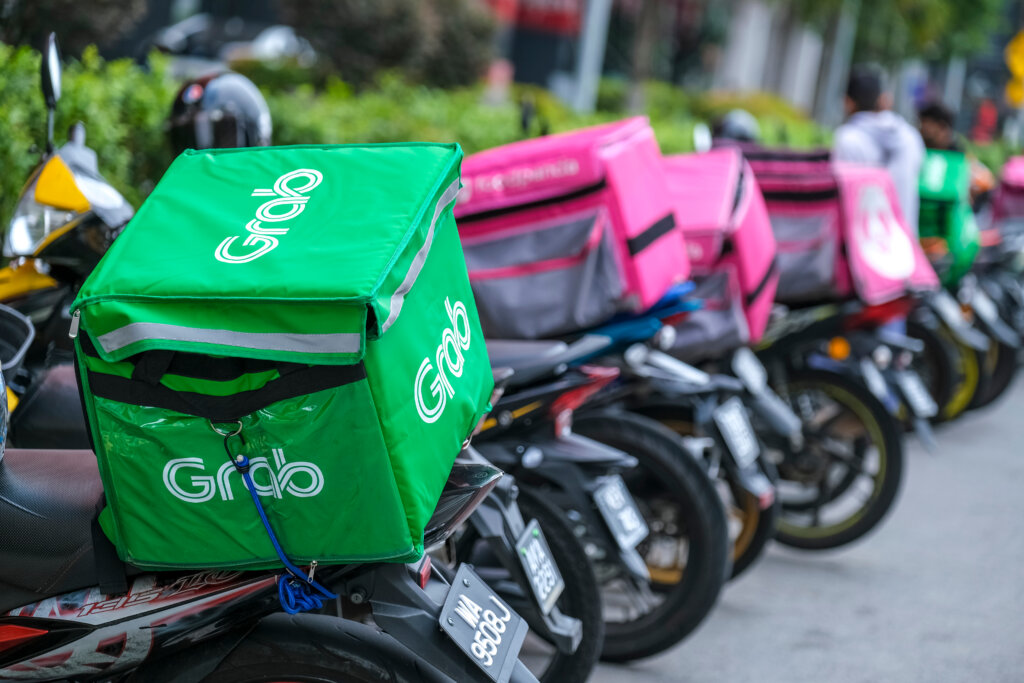
End of the road for foodpanda? (Image – Shutterstock)
Online food delivery companies in ASEAN running out of recipes for success
- Online food delivery companies have been struggling.
- Delivery Hero is considering selling foodpanda; Grab may be interested in acquiring the food delivery company.
Online food delivery companies in Southeast Asia made record profits during the COVID-19 pandemic. Not only did some of these companies increase their revenue, but many new players also entered the industry, with the hopes of getting a piece of the pie.
From 2020 to the middle of 2022, food delivery companies were profitable. But as the pandemic came to an end and people started going back to work in offices, the need for online food delivery services reduced significantly.
In fact, according to a report by Momentum Works, food delivery companies in Southeast Asia only experienced a modest 5% growth to reach US$16.3 billion in 2022 after two years of good business during the pandemic.
Currently, Grab is the leader in Southeast Asia’s food delivery market, holding 54% of the region’s gross merchandise value in 2022, while Foodpanda captured 19% and Gojek held 12%, according to the report.
In the last several months as well, several online food companies have had to reduce their workforce, with some companies even shutting down their entire food delivery service. This includes Grab, who laid off more than one thousand people, or about 11% of its staff. This not only included employees in its food delivery app, GrabFood but also its other app services.
The superapp has been having a rather interesting year, filled with lots of changes as it looks to supercharge its digital banking ambitions. As statistics show, GrabFood remains one of the top online food delivery platforms in Southeast Asia, despite the economic conditions.
Meanwhile, AirAsia, which made a lot of noise when it entered the online food delivery industry, had also made some strategic changes to its services. With air travel booming, the airline company has decided to keep its focus on travel and ride-hailing instead of carrying on with its food delivery journey.
The airline company had already stopped its food delivery service in Singapore since January 2023. However, it didn’t just terminate the service completely. Instead, AirAsia took a more consolidated approach. The airline company signed a partnership with foodpanda, another online food delivery giant instead. The partnership, which was announced just a few months ago in Malaysia, will see AirAsia’s food delivery services be handled by foodpanda.
Put simply, those who want to order food on the Airasia superapp will be directed to foodpanda’s app instead. Similarly, foodpanda customers can also book air tickets and such on the foodpanda app, as they will be redirected to the Airasia superapp.

Which service did you enjoy most? (Image – Shutterstock)
Food delivery companies are no longer profitable?
As predicted, the online food delivery industry is no longer as profitable as many thought it would be. Not only was the return to work a reason for the dropping profits, many riders working in the industry returned to full-time jobs.
The gig economy, especially for delivery riders, was simply no longer profitable. Many riders were also struggling to cope with the rising prices, especially with inflation. Diners themselves have reduced their spending on deliveries and are opting for cheaper alternatives, opting to cook and eat at home.
At the same time, the smaller online food delivery companies just could not cope with the rising costs. Singapore-based food delivery platform Gobble closed down earlier this year because of low-profit margins and a lack of positive cash flow.
Singapore’s Deliveroo also laid off a portion of its global staff, with roles at all levels of the company affected. In a report by Channel News Asia, an internal memo by Deliveroo founder and Chief Executive Will Shu stated that around 9% of the company’s workforce, with approximately 350 roles was cut, although the actual number of staff laid off is estimated to be about 300, after redeployments.
foodpanda also reported layoffs, with a third round announced on the 21st of September. In Malaysia, Online grocery delivery service HappyFresh ceased operations due to the current economic situation late last year.
Over in Thailand, Line Man, a delivery app founded by the Thai unit of Japan’s Line Corp., reported a loss of US$75.9 million last year, down 14% from 2021, despite growing revenue 88% to US$219 million, according to analytics firm Creden Data. The Kasikorn Research Center, a think tank in Bangkok, has estimated that the market value of the food delivery business in Thailand will shrink this year by 0.6 percent compared with 2022 as the volume of food orders declines post-pandemic.
India’s Zomato, also shut down its food delivery services in the Philippines and Indonesia earlier this year. Although it was more of a restaurant aggregator for food delivery, the company has been in the Philippines for almost a decade.

What will happen to foodpanda if Grab acquires them? (Image – Shutterstock)
Consolidation is the way forward
Given the state of the food delivery industry, most of these companies are already looking for ways to consolidate their operations. AirAsia has made the first brave move of admitting that the food delivery arena is not its area of expertise. While it did get some profit initially, consolidating services with foodpanda seemed like the most reasonable thing to do.
In fact, not only does this reduce the competition in the industry, but it also helps both companies to focus on what they do best. The airline superapp definitely has high ambitions in other areas and the partnership with foodpanda seems to be allowing it to focus on achieving those goals.
foodpanda has become a household name for online food delivery across all of Asia. The company may not have the ambitions of becoming a super app like Grab or AirAsia but likes to believe that it’s already a superapp in the food delivery industry.
True enough, the main competition in the industry is between Grab and foodpanda. There are other small players like Beep in Malaysia and Deliveroo in Singapore. Unlike Grab, which has other areas of business such as ride-hailing and digital banking, foodpanda relies purely on food delivery.
According to recent news reports, foodpanda is now looking at ways to consolidate its business even more. The company has already executed two rounds of layoffs, with a third one announced last week.
“We are sorry to confirm that we had to reduce our team size in the APAC region on 21 September, as the need to streamline our operations to become leaner and more agile remains critical. In the coming days and weeks, our focus is on supporting impacted colleagues through this difficult time.
We are extremely sorry to colleagues who are leaving us and are grateful for their contributions to foodpanda,” stated the company.
But what’s more interesting this time round is that reports are stating that the parent company of foodpanda, Delivery Hero is in discussions to sell its food delivery business in selected Southeast Asia markets.
In an email to CNBC, Delivery Hero confirmed that there are “negotiations with several parties regarding a potential sale of its foodpanda business in selected Southeast Asia markets. Any discussions or plans are in their preliminary stages.”

Report on Delivery Hero selling foodpanda.
Grab to acquire foodpanda?
German media outlet WirtschaftsWoche reported that Delivery Hero is selling its operations under the foodpanda brand in Singapore, Cambodia, Malaysia, Myanmar, Philippines, Thailand and Laos. The German media report also said that competitor Grab could be a buyer.
Should Grab acquire foodpanda, it will most likely have a monopoly in the food delivery industry in the region. Grab is already a leader in the ride-hailing industry after acquiring Uber’s Southeast Asia business. Apart from Indonesia’s Gojek, Grab is pretty much untouchable in other Southeast Asian countries in the ride-hailing industry.
In the food delivery industry, Grab acquiring foodpanda could have several outcomes. As with any acquisition, employees are always the first concern. Grab itself has executed layoffs this year, so many employees would definitely be worried about the status of their employment should the acquisition happen.
Next, a lot of businesses actually prefer working with foodpanda instead of Grab. For example in Malaysia, there are more local food vendors operating on foodpanda as compared to Grab. In terms of riders, both companies have their fair share of ups and downs with riders.
While the entire acquisition will most likely benefit Grab, one could wonder on the status of the partnership with AirAsia. It remains to be seen how the partnership will continue should an acquisition take place.
Tony Fernandes, CEO of Capital A and AirAsia has continued to voice his desire to compete to be better than the “green” brand. This was also why he launched the ride-hailing and food-delivery services in the first place. While AirAsia will most likely be out of the acquisition picture, foodpanda could actually be a dark horse for them if they have the right plans in place.
For now, though, Grab is seemingly in line to remain the dominant online food delivery company in the region. And should this acquisition go through, the company is definitely on its way to not just being a powerful superapp, but a dominant one in the region. Put simply, Grab could be getting the ingredients it needs to have the perfect recipe for success.
READ MORE
- Safer Automation: How Sophic and Firmus Succeeded in Malaysia with MDEC’s Support
- Privilege granted, not gained: Intelligent authorization for enhanced infrastructure productivity
- Low-Code produces the Proof-of-Possibilities
- New Wearables Enable Staff to Work Faster and Safer
- Experts weigh in on Oracle’s departure from adland








